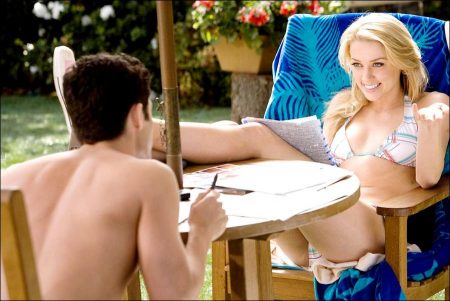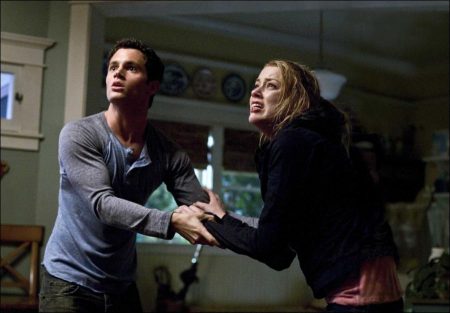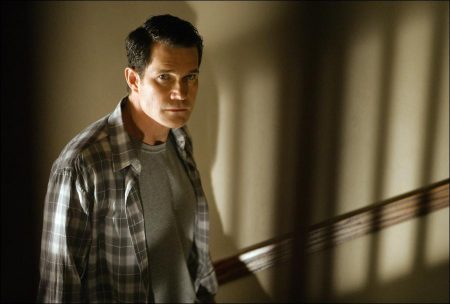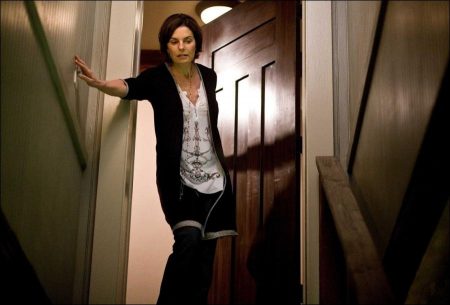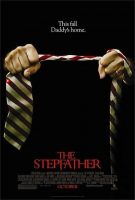The Stepfather movie storyline. When troubled teen Michael (Penn Badgley) returns home after a year at military school, he finds his mother, Susan (Sela Ward), in love and his soon-to-be stepfather, David (Dylan Walsh), has moved into their home. David says he wants them to become the perfect family. But as they get to know each other, Michael quickly becomes convinced that David himself is far from perfect.
Trying to verify what he knows of David’s past, Michael finds things that don’t add up. As strange events and David’s bursts of malevolence become more frequent, Michael tells his mother and girlfriend of his suspicions, but they just think he’s being paranoid. Eventually, as Michael searches for proof that his suspicions are well-founded, cracks begin to show in David’s perfect façade…and it becomes apparent he will stop at nothing to keep his secrets.
For David has a history of trying to create the perfect family. And each time, when it becomes apparent that perfection is impossible, David has a terrifying way of clearing the slate and starting over. As the film’s events rocket towards a shocking final confrontation, it’s up to Michael to protect his family from the evil that’s been awakened once more in David.
The Stepfather is a 2009 American horror thriller film and a remake of the 1987 horror film of the same title. The film was directed by Nelson McCormick and stars Penn Badgley, Dylan Walsh and Sela Ward. The original was directed by Joseph Ruben and shot from a script by Donald Westlake. The films are loosely based on the crimes of mass murderer John List (who died in prison custody on March 21, 2008 at the age of 82 before its release).
About the Production
The Stepfather is an edge-of-your-seat popcorn thriller, a roller coaster ride the audience can enjoy in the comfort of a darkened theater. But the story behind the new film (and its 1987 predecessor) is actually rooted in horrifying fact. This reinvention of the film came about when producer Greg Mooradian was watching a Bravo television special on the 100 greatest horror movies ever made and saw that the original The Stepfather was included on the list. It was actually one of the few films mentioned he had not seen, but upon viewing it and talking with producing partner Mark Morgan, they felt it was ripe for being remade.
“The Stepfather is a remake,” says director Nelson McCormick, “but rather than invest ourselves in what the original did, we wanted to delve more into the characters. The original “Stepfather” was the story of a man who lived in New Jersey and decided he had to murder his family. He murdered his wife, his three teenage kids, and his mother, then moved to Colorado, assumed a new life, married, and changed his name. It wasn’t discovered until 18 years later that he was, in fact, the same man.
“We thought that was fascinating,” McCormick continues. “The character flaw, the tragic gene that pushed him to the edge – that’s what we focused on in this version of The Stepfather.” With that in mind, the filmmakers began crafting their new stepfather: David Harris.
For The Stepfather, the words on the page are full of menace and the images they conjure are strong, but to actually bring the villain to life, the filmmakers turned to actor Dylan Walsh. Walsh and director McCormick had previously worked together on the award-winning show Nip/Tuck, and throughout his many seasons on that show, Walsh had gotten to show many sides to his acting talent. But McCormick knew there were untapped aspects of his talent he hadn’t yet been able to showcase and thought he’d be perfect for the role. “Dylan has enormous talent, enormous chops,” McCormick says. “You didn’t often get a chance to see that on Nip/Tuck because it’s very defined who he has to be on that show. But there’s so much more to him. He’s so gifted at navigating himself through a scene.”
For his part, Walsh was thrilled to take on such a character. He knew creating Harris would be a huge challenge, but also a fascinating exercise, a thrilling acting experiment in walking a tightrope between believability and delicious evil. Together, Walsh and McCormick and the filmmakers worked on making the character terrifying, but always with one foot firmly rooted in reality, knowing the idea of a killer that could and did exist was much more frightening.
“Dylan and I spoke a lot about his character’s rationale for doing what he’s doing,” says McCormick. “Harris truly wants a family, and he’s deluding himself with this illusion that `If I have what appears to be a happy family, then happiness should follow.’ His logic is simply to find a woman with children that he can then graft himself onto and make a family work.”
In speaking of his character, Walsh says, “Imagine a guy who has an obsessive need to be at the head of a family with a kind of 1950s dynamic, where the father would be the king of his castle. Harris has such a need for that that he finds these vulnerable women, either widowed or divorced and they have kids, and he wants to come into that family and take over. He means well; he does good things for them, and he’s empowered by doing good things.
“The problem is,” he continues, “there’s a clash between this 1950s king of the castle idea and the way families are now. I’m a father, so I know it’s much less a king of the castle thing. We’ve moved on, progressed, and there’s a give and take – nobody’s the captain. It’s complicated and there are gray areas you have to navigate and finesse, and it’s harder work. And this clash of these two dynamics makes this guy crazy. He’s a control freak, and when he loses control, his way of dealing with it is to kill the family.” “He jumps to the ultimate conclusion,” adds McCormick, “which is to kill them, then start over again in the next town or next life.”
A serial killer is scary enough, but the fact that Harris is a soon-to-be stepfather adds another layer of horror to the story. Being a stepfather, says Walsh, “is such a common thing. More and more families are patched together – stepfathers, stepmothers, kids from different marriages. You’re bringing somebody into a very intimate family situation. And the movie plays with that, the fear of `Who is this person I’m bringing into my closed circle?’”
As mentioned, Walsh found himself walking an acting tightrope. He has to play Harris “normal enough” to pass as normal to the other characters, but evil enough that the audience enjoys watching him try to hide it. “It’s not a whodunit. We know who done it,” Walsh laughs. “It’s more about watching something unfold and the cringing tension you feel in the audience as this unsuspecting family takes in a man who has just killed his own family. It’s about `How is this going to play out? Who’s going to be a hero? Where is Harris going to trip up?’ That’s what’s interesting.”
McCormick adds, “One of the things that was brilliant about the original film was its opening, and we embraced that. The idea of telling the audience right from the beginning that our main character is, in fact, a murderer was something we wanted to open with. It’s stunning to watch a man get up and go through his morning routine while there are dead bodies lying around that he murdered the night before.
“As far as characters go, you won’t get anybody more complex,” continues Walsh. “To look at him, he should seem harmless. And if you don’t achieve that, then the second thing [his murderous side] won’t work. And if you can’t go to the second thing, you don’t have a thriller. I was aware of that and tried not to think about it too much, to just let it happen.”
Of Walsh, McCormick says, “It’s a careful performance Dylan creates in this film because it has to be one that you can then rewind and look at a second time and say, `Oh, my gosh. He was totally crazy and they just didn’t see it.’ But going through it the first time, you can also see how they were blind to it because he is charming. He’s a gentleman.”
With such a diabolical villain, a film also needs a strong hero, and in The Stepfather, the hero is embodied by accomplished young actor – and handsome heartthrob – Penn Badgley. Badgley, famous for his role on the breakout hit Gossip Girl, was eager to take on the role of David Harris’ intended stepson Michael, setting aside Upper East Side drama for a taste of suburban thriller.
One of the things Badgley found most interesting about The Stepfather was the fact that – as Walsh mentioned – the murderer is never an unknown. “You know from the beginning he’s a killer,” he says. “This family that at one point was shattered, they’ve rebuilt themselves with this guy – but he’s clearly a bad egg. The tension and the thrills come from dread, waiting for things to play out. It’s not the kind of tension people are used to and scary.”
“Waiting is a big part of making these films work,” adds McCormick. “It’s the slow twisting of the knot that builds tension you can feel in your gut. It’s both satisfying and painful at the same time to watch as an audience member – that’s what makes these films fun. It just gets tighter and tighter until the very end. Before long, you’re one of the family members just trying to survive. That’s how it feels. That’s how invested you get in these characters.”
“The audience is always in the know,” he continues, “and the characters are just flying by the seat of their pants. My character, Michael, in that sense, is like the audience’s eyes and ears – he’s seeing the most,”
Badgley found Michael’s predicament fun to play. Michael is a young man convinced of his soon-to-be stepfather’s villainy…only no one will believe him. “David seems to be the perfect man… except that he’s a serial killer,” Badgley laughs. “At first, David tries very hard to win Michael over. But he’s obviously a bit off, and Michael sees that, so he feels alienated in his own home.” Rooting for Michael and what he’s up against gives the audience someone to identify with… and root for.
And there are no easy answers for the situation in which Michael finds himself – he can’t even necessarily trust his own thoughts. “It’s very strange for him,” says Badgley. “Everyone’s against him; they just think he’s paranoid. And he doesn’t really want to tell anybody, because it does seem crazy for someone to think their stepfather is a murderer. Even when it starts to seem pretty convincing, Michael, as convinced as he may be, is like, `Yeah… but this is nuts.’”
Badgley echoes the filmmakers when he speaks of wanting to root the work in reality. “We did rehearsals beforehand and were trying to instill as much depth in it as possible,” he says. “A line we’d use was, `Hopefully this would be a good movie even without the killing.’ Even without the tension of David being a serial killer, it’s a family trying to build itself again and there’s a tense, awkward relationship between the oldest son and the stepfather.”
Michael hates his stepfather in the film, but Badgley himself really enjoyed working with co-star Walsh, though the two kept a bit of distance to lend a wariness to their portrayals. “He was very quiet at first, and I am too, so we didn’t really talk much,” Badgley says. “But he was very committed and passionate and was dealing with a hard role.”
The young actor also marveled at Walsh’s transformation into “evil stepfather.” “He’s got this grimace,” he says, “this scowl his face just settles into. I don’t know how he does it – his mouth just turns down and his cheeks sag and he looks around with this killer stare. It’s really scary.”
Of his co-star, Walsh has high praise. “Penn is a very contemplative guy,” he says. “He’s articulate, and for as young as he is, he has a maturity. He’s a very smart guy. I really like his demeanor – he works hard, and he’s quietly funny.”
Just as Walsh and Badgley’s performances in The Stepfather are departures from what most audiences have seen them do, Sela Ward’s turn as Michael’s mother, Susan, is a full leap into unexplored territory. In fact, the actress readily admits she doesn’t usually like the genre at all.
“I don’t watch these movies because they just scare me to death,” she laughs. “But in remembering Hitchcock films when I was young, they were always so interesting and suspenseful. My best hope was that this would be equivalent in some way, and I think it’s very much Hitchcockian. It’s shot really well, very stylized, and it’s very suspenseful. You’re waiting any moment for the other shoe to drop, and that’s always really fun.”
Of her decision to join the cast, Ward says she remembers sitting down with director McCormick. “I’d already read the script, and I love Dylan Walsh and knew Penn Badgley – I knew I’d be surrounded by good actors. I said, `Nelson, I’ll only do this if you promise you’ll protect me, because I’m not used to screaming at rubber knives.’ It’s hard to react to a rubber knife and screaming is not my forte. I come from that whole relationship world of dialogue, so it was really a challenge.
“The hardest thing for me,” she continues, “was to really go for screaming bloody murder. You’re afraid you’re going to be so over the top. I would never have known how tricky this was – you cannot underestimate acting this kind of material. What I, on the page, would think is a piece of cake, the reality is that I struggled with it, to really bring that fear. This is so heightened in its reality that it’s a fine line to make it truthful, and that’s been the biggest surprise, being able to show terror and fear in a convincing way. It’s been a great learning experience. You hope you can pull it off as real as possible, and the story is such that I think you’re able to do that.”
One of the things that helped Ward find her character’s terror was realizing how normal Walsh’s Harris seems at first. “Who knows how many women have been in this position?” she posits. “The Ted Bundys of the world, charming and good-looking and smart. You wouldn’t think twice about having dinner with them – and all of a sudden they’re just completely psycho.
“This movie does beg you to ask the question, `Who are you getting involved with? Who are you letting into your life?’” she continues. “I think we come from a generation that was very trusting in people. And now that everyone’s so transient and disenfranchised from their sense of community, you have to be very careful, because you really don’t know about Joe Smith over there.
“In Meridian, Mississippi, where I’m from, I could have walked down the street and have somebody stop and say, `Hey, I’m so-and-so’s cousin. I’ve been dying to meet you. You want to go have a cup of coffee?’ `Sure, let’s go,’ I’d say, because you know you’re safe within certain parameters. This film is a really interesting look at how large our world is today and how unsafe that can be.”
Looking at her character on more personal terms, Ward also finds Susan’s predicament even more acutely relatable. “I think women have always been vulnerable to a man desiring them, paying attention to them,” she says, “particularly when divorced, particularly once you get older. It’s a very vulnerable place to be. It really touches a nerve, and I think that’s what’s so scary about it. It’s one of those movies where you sit there and go, `My god, this could happen to me.’”
McCormick adds, “Susan doesn’t realize until she meets this guy just how hungry she is for a relationship, for somebody to be with who takes pride in being with her. That feels so good and ignites this sort of flame inside of her that had flickered out for a long time. I think a lot of people get to that point in their life where they go, `Why can’t I have the happiness everybody else has?’ Susan’s at that point when she meets David, which is why she’s blind to some of the hidden faults and character flaws he has. It isn’t until after a relationship goes completely sour that you’re able to look back and go `What was I thinking?’”
To round out the main cast, for the role of Michael’s girlfriend, Kelly, the filmmakers wanted a typical “girl-next-door.” In auditions, when they saw how well actress Amber Heard played off Penn Badgley, they knew they had to give her the role. “They had a lot of fun together and that turned out to be most important factor,” says McCormick.
Heard was thrilled to join the cast and quickly grew quite attached to her character. “I love how in this film Kelly is such a strong part of the family,” she says. “She’s the girlfriend, but she’s a longtime girlfriend, and she’s a very prominent member of the family. And when things start to fall apart, she ends up being a very important element in the final few scenes.”
The director was glad to have her in the cast as well. “Amber has the gift to immediately invest herself in any moment, and that was so useful because Penn’s character was sort of reticent and she drew him out beautifully,” McCormick says.
Of her on-screen boyfriend (Badgley), Heard says, “He’s an amazing person. He’s really nice, he’s talented, he’s focused.” She’s equally effusive about Walsh: “Dylan’s an amazing actor,” she says.
With their work done on the film, the cast and filmmakers are excited for audiences to finally get to experience The Stepfather. “You’re watching these characters, these poor characters who don’t know it’s going to get so bad,” Heard says. “You’re like, `Turn around! Open your eyes! Look over there!’ – it keeps you at the edge of your seat. It’s exciting and it’s emotionally and psychologically captivating…and it’s fun.” Badgley sums things up by saying, “I hope audiences get scared. I hope they’re thrilled. We’re here to entertain, so I hope that’s what they get. And maybe people will go home to their stepparents and check under the bed.”
Home Sweet Home
Dylan Walsh says his character is attached to the idea of being “king of his castle.” To create the perfect “castle” for Walsh’s diabolical stepfather, the filmmakers called upon production designer Steven Jordan “In all of my work I treat the sets as characters,” says Jordan. To “cast” the house in The Stepfather, he had to find something with everything the script called for, something that would work for the stunts and specifications the story demanded. “We decided on the Craftsman style because it lent itself most to good visuals – an expansive first floor and lots of depth and lighting possibilities,” he says. “We did an exhaustive search of Craftsman homes in Pasadena, but we needed a home with a swimming pool, certain sight lines from rooms in the home, and a third story with an attic.”
Because of the film’s Portland, Oregon, setting, they also had to find a home without palm trees – not so easy in palm-lined Pasadena. They found several homes with two of their three requirements, and ultimately fell in love with beautiful house that was perfect…except it only had two stories. To remedy the situation, “I actually had the design team design and build a third story attic that we sat on the roof of the home and painted to match. “It was actually rather successful,” he laughs. “Neighbors would come by and felt it had always been there.”
They shot in the house and also used its newly-three-story status for exteriors, including the climactic fight that bursts from the attic onto the backyard below. For interior attic shots, they built a replica of the third story attic on a soundstage.
The challenges in designing a movie that takes place in a home include facilitating a variety of lighting requirements, accommodating dramatic camera movements, and enabling enough arresting angles from which to shoot. Jordan focused on creating “a set that had enough depth, windows, and architectural interest to sustain that volume of work.”
He and his team also worked hard to give the home a realistic, lived-in family feel. “It’s so important to create a place where the actors feel motivated and really feel at home,” Jordan says. “The decorators spend a lot of time helping develop the characters through their use of set dressing.” Stepping into the minds of the actors (and often working with them), the design team looked for answers to questions like, “Where do I pay bills? Where’s my computer? Where’s the garbage can, so I can use it when I’m working at the computer writing my bills?”
For instance, Jordan says, “For Sela’s character, we turned her into a bit of a cook and a collector.” They stocked her home with Roseville pottery. “Roseville was the natural thing, given the vintage of the home and the abundance of it in the Western United States.” Befitting a thriller, the decorators also carefully sprinkled the house with “weapons of mass destruction in every room,” Jordan laughs. “It’s nuanced. You try to foreshadow in very subtle ways. Knives and tools everywhere, but to give the audience credit you’re subtle in how you do it.”
Overall, knives or not, Jordan repeats the same mantra oft-repeated by The Stepfather’s director and cast. “It’s about everything being based in reality,” he says. In making a film, “all of us, no matter what your craft, are storytellers.”
The Stepfather (2009)
Directed by: Nelson McCormick
Starring: Dylan Walsh, Sela Ward, Penn Badgley, Adrianne Palicki, Amber Heard, Paige Turco, Braeden LeMasters, Skyler Samuels, Jon Tenney, Sherry Stringfield, Deirdre Lovejoy, Blue Deckert
Screenplay by: Joe Cardone
Production Design by: Steven J. Jordan
Cinematography by: Patrick Cady
Film Editing by: Eric L. Beason
Costume Design by: Lyn Paolo
Set Decoration by: Julieann Getman
Art Direction by: Tim Eckel
Music by: Charlie Clouser
MPAA Rating: PG-13 for intense sequences of violence, disturbing images, mature thematic material and brief sensuality.
Distributed by: Sony ScreenGems
Release Date: October 16, 2009
Views: 139
